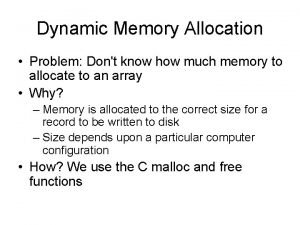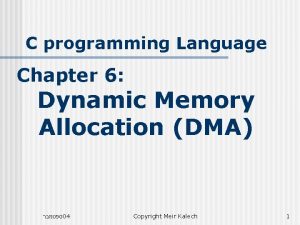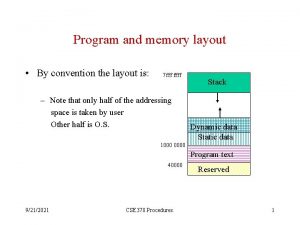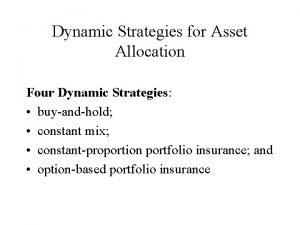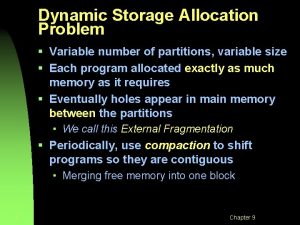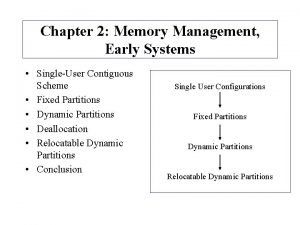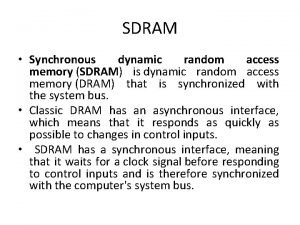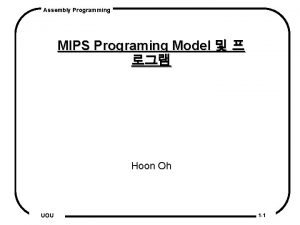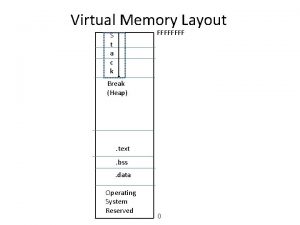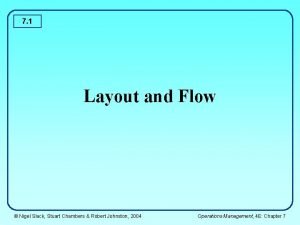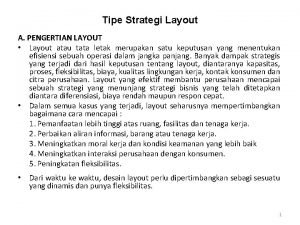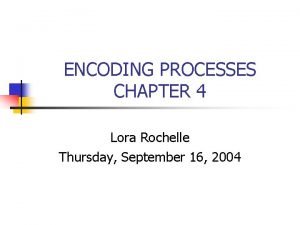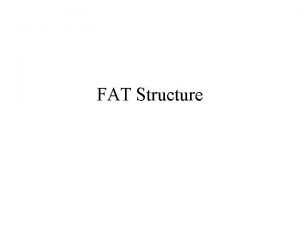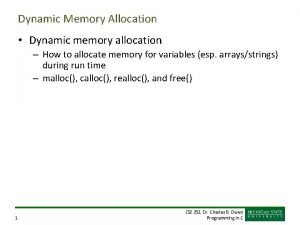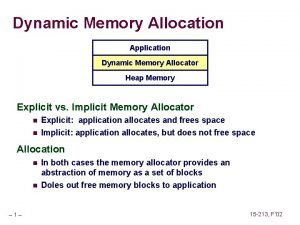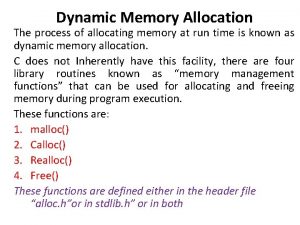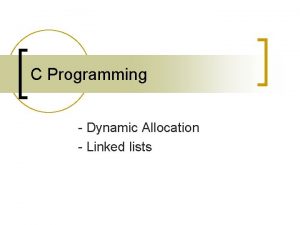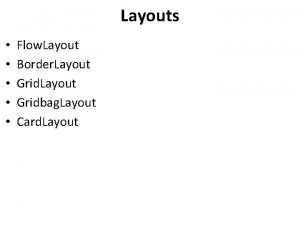Dynamic Memory Allocation Agenda Process Layout Memory Allocation









































































































































- Slides: 137

Dynamic Memory Allocation

Agenda • Process Layout • Memory Allocation Algorithms • Garbage Collection Algorithms Reference: Ch. 5. 7 and 8. 5

Process Layout lower addresses executable code (text) static data (e. g. globals) heap stack higher addresses

Process Layout lower addresses executable code (text) valid addresses static data (e. g. globals) heap higher addresses valid addresses stack

Process Layout lower addresses executable code (text) static data (e. g. globals) rigid valid addresses rigid heap changed with sbrk() stack higher addresses valid addresses changed by calling and returning from functions

sbrk() • #include <unistd. h> • Prototype: void *sbrk(ptrdiff_t increment); • Increases or decreases the address of the bottom of the heap • Returns the previous address • sbrk(0) can be used to obtain the current address • Implementation of sbrk() is operating system dependent

Example • Compiled on queen using gcc, this program produces the following output: 0 x 00020908 #include <stdio. h> #include <stdlib. h> #include <unistd. h> int main() { printf("0 x%08 pn", sbrk(0)); 0 x 00022908 malloc(1024); printf("0 x%08 pn", sbrk(0)); return 0; }

What happened… • Initially, the heap ended at 0 x 00020908 executable code (text) static data (e. g. globals) 0 x 00020908 stack

What happened… • Initially, the heap ended at 0 x 00020908 • Then I said that I needed an additional 1 k executable code (text) static data (e. g. globals) 0 x 00020908 stack

What happened… • Initially, the heap ended at 0 x 00020908 • Then I said that I needed an additional 1 k • So malloc() increased the heap size by 8 k executable code (text) static data (e. g. globals) 0 x 00020908 0 x 00022908 stack

Agenda • Process Layout • Memory Allocation Algorithms – Fixed Size – Variable Size • • First-Fit Next-Fit Best-Fit The Buddy Algorithm • Garbage Collection Algorithms

Fixed Size Algorithm • Maintain a list of free blocks (the free-list) • To allocate a block, pop one off the front of the list • To free a block, push it back onto the front of the list

Fixed Size Algorithm Obtain a large chunk of memory

Fixed Size Algorithm Divide it up into blocks of the appropriate size

Fixed Size Algorithm Give each of the blocks a four-byte header

Fixed Size Algorithm front Use these headers as next-pointers, and arrange the blocks into a linked list

Fixed Size Algorithm front To allocate a block, pop one off the front of the list, e. g. p 1 = alloc(); p 2 = alloc(); p 3 = alloc();

Fixed Size Algorithm front p 1 To allocate a block, pop one off the front of the list, e. g. p 1 = alloc(); p 2 = alloc(); p 3 = alloc();

Fixed Size Algorithm front p 1 p 2 To allocate a block, pop one off the front of the list, e. g. p 1 = alloc(); p 2 = alloc(); p 3 = alloc();

Fixed Size Algorithm front p 1 p 2 p 3 To allocate a block, pop one off the front of the list, e. g. p 1 = alloc(); p 2 = alloc(); p 3 = alloc();

Fixed Size Algorithm front p 1 p 2 p 3 To free a block, push it back onto the front of the list, e. g. free(p 1); free(p 3); free(p 2);

Fixed Size Algorithm front p 1 p 2 p 3 To free a block, push it back onto the front of the list, e. g. free(p 1); free(p 3); free(p 2);

Fixed Size Algorithm front p 1 p 2 p 3 To free a block, push it back onto the front of the list, e. g. free(p 1); free(p 3); free(p 2);

Fixed Size Algorithm front p 1 p 2 p 3 To free a block, push it back onto the front of the list, e. g. free(p 1); free(p 3); free(p 2);

Fixed Size Algorithm front Note that the list is not usually kept sorted by address

Agenda • Process Layout • Memory Allocation Algorithms – Fixed Size – Variable Size • • First-Fit Next-Fit Best-Fit The Buddy Algorithm • Garbage Collection Algorithms

Variable Size Algorithms* • Maintain a list of free blocks (the free-list) • To allocate a block, find a block of sufficient size and remove it from the list • To free a block, insert it into the list, keeping the list sorted by address * The Buddy Algorithm does not adhere to this overall scheme.

Variable Size Algorithms • Both free and allocated blocks have headers • The composition of the headers will vary with the implementation • Example user data size Allocated Block: unused next free block size Free Block:

Variable Size Algorithms user data Allocated Block: size From the memory manager’s perspective, the block starts before the headers From the user’s perspective, the block starts after the headers

unused next free block 8 k unused 4 k 12 k Variable Size Algorithms • Adjacent free blocks must be coalesced

Finding a block of sufficient size • At least three approaches – First-Fit • Find the first block in the list of sufficient size – Next-Fit – Best-Fit

Variable Size: First-Fit front 16 k Example: p 1 = alloc(2 k); p 2 = alloc(1 k); p 3 = alloc(5 k); p 4 = alloc(1 k); p 5 = alloc(4 k); p 6 = alloc(1 k); free(p 1); free(p 3); free(p 5); p 7 = alloc(3 k); free(p 6); p 8 = alloc(1 k); p 9 = alloc(6 k);

Variable Size: First-Fit front 2 k 14 k p 1 Example: p 1 = alloc(2 k); p 2 = alloc(1 k); p 3 = alloc(5 k); p 4 = alloc(1 k); p 5 = alloc(4 k); p 6 = alloc(1 k); free(p 1); free(p 3); free(p 5); p 7 = alloc(3 k); free(p 6); p 8 = alloc(1 k); p 9 = alloc(6 k);

Variable Size: First-Fit front 2 k p 1 Example: 1 k 13 k p 2 p 1 = alloc(2 k); p 2 = alloc(1 k); p 3 = alloc(5 k); p 4 = alloc(1 k); p 5 = alloc(4 k); p 6 = alloc(1 k); free(p 1); free(p 3); free(p 5); p 7 = alloc(3 k); free(p 6); p 8 = alloc(1 k); p 9 = alloc(6 k);

Variable Size: First-Fit front 2 k p 1 Example: 1 k 5 k 8 k p 2 p 3 p 1 = alloc(2 k); p 2 = alloc(1 k); p 3 = alloc(5 k); p 4 = alloc(1 k); p 5 = alloc(4 k); p 6 = alloc(1 k); free(p 1); free(p 3); free(p 5); p 7 = alloc(3 k); free(p 6); p 8 = alloc(1 k); p 9 = alloc(6 k);

Variable Size: First-Fit front 2 k p 1 Example: 1 k 5 k p 2 p 3 p 1 = alloc(2 k); p 2 = alloc(1 k); p 3 = alloc(5 k); p 4 = alloc(1 k); p 5 = alloc(4 k); p 6 = alloc(1 k); free(p 1); 1 k 7 k p 4 free(p 3); free(p 5); p 7 = alloc(3 k); free(p 6); p 8 = alloc(1 k); p 9 = alloc(6 k);

Variable Size: First-Fit front 2 k p 1 Example: 1 k 5 k p 2 p 3 p 1 = alloc(2 k); p 2 = alloc(1 k); p 3 = alloc(5 k); p 4 = alloc(1 k); p 5 = alloc(4 k); p 6 = alloc(1 k); free(p 1); 1 k 4 k p 4 p 5 free(p 3); free(p 5); p 7 = alloc(3 k); free(p 6); p 8 = alloc(1 k); p 9 = alloc(6 k); 3 k

Variable Size: First-Fit front 2 k p 1 Example: 1 k 5 k p 2 p 3 p 1 = alloc(2 k); p 2 = alloc(1 k); p 3 = alloc(5 k); p 4 = alloc(1 k); p 5 = alloc(4 k); p 6 = alloc(1 k); free(p 1); 1 k 4 k p 4 p 5 1 k p 6 free(p 3); free(p 5); p 7 = alloc(3 k); free(p 6); p 8 = alloc(1 k); p 9 = alloc(6 k); 2 k

Variable Size: First-Fit front 2 k p 1 Example: 1 k 5 k p 2 p 3 p 1 = alloc(2 k); p 2 = alloc(1 k); p 3 = alloc(5 k); p 4 = alloc(1 k); p 5 = alloc(4 k); p 6 = alloc(1 k); free(p 1); 1 k 4 k p 4 p 5 1 k p 6 free(p 3); free(p 5); p 7 = alloc(3 k); free(p 6); p 8 = alloc(1 k); p 9 = alloc(6 k); 2 k

Variable Size: First-Fit front 2 k p 1 Example: 1 k 5 k p 2 p 3 p 1 = alloc(2 k); p 2 = alloc(1 k); p 3 = alloc(5 k); p 4 = alloc(1 k); p 5 = alloc(4 k); p 6 = alloc(1 k); free(p 1); 1 k 4 k p 4 p 5 1 k p 6 free(p 3); free(p 5); p 7 = alloc(3 k); free(p 6); p 8 = alloc(1 k); p 9 = alloc(6 k); 2 k

Variable Size: First-Fit front 2 k p 1 Example: 1 k 5 k p 2 p 3 p 1 = alloc(2 k); p 2 = alloc(1 k); p 3 = alloc(5 k); p 4 = alloc(1 k); p 5 = alloc(4 k); p 6 = alloc(1 k); free(p 1); 1 k 4 k p 4 p 5 1 k p 6 free(p 3); free(p 5); p 7 = alloc(3 k); free(p 6); p 8 = alloc(1 k); p 9 = alloc(6 k); 2 k

Variable Size: First-Fit front 2 k p 1 Example: 1 k 3 k p 2 p 7 p 3 p 1 = alloc(2 k); p 2 = alloc(1 k); p 3 = alloc(5 k); p 4 = alloc(1 k); p 5 = alloc(4 k); p 6 = alloc(1 k); free(p 1); 2 k 1 k 4 k p 4 p 5 1 k p 6 free(p 3); free(p 5); p 7 = alloc(3 k); free(p 6); p 8 = alloc(1 k); p 9 = alloc(6 k); 2 k

Variable Size: First-Fit front Coalesced 2 k p 1 Example: 1 k 3 k p 2 p 7 p 3 p 1 = alloc(2 k); p 2 = alloc(1 k); p 3 = alloc(5 k); p 4 = alloc(1 k); p 5 = alloc(4 k); p 6 = alloc(1 k); free(p 1); 2 k 1 k 7 k p 4 p 5 p 6 free(p 3); free(p 5); p 7 = alloc(3 k); free(p 6); p 8 = alloc(1 k); p 9 = alloc(6 k);

Variable Size: First-Fit front 1 k 1 k 1 k p 8 p 1 Example: 3 k p 2 p 7 p 3 p 1 = alloc(2 k); p 2 = alloc(1 k); p 3 = alloc(5 k); p 4 = alloc(1 k); p 5 = alloc(4 k); p 6 = alloc(1 k); free(p 1); 2 k 1 k 7 k p 4 p 5 p 6 free(p 3); free(p 5); p 7 = alloc(3 k); free(p 6); p 8 = alloc(1 k); p 9 = alloc(6 k);

Variable Size: First-Fit front 1 k 1 k 1 k p 8 p 1 Example: 3 k p 2 p 7 p 3 p 1 = alloc(2 k); p 2 = alloc(1 k); p 3 = alloc(5 k); p 4 = alloc(1 k); p 5 = alloc(4 k); p 6 = alloc(1 k); free(p 1); 2 k 1 k 6 k p 4 p 9 p 5 1 k p 6 free(p 3); free(p 5); p 7 = alloc(3 k); free(p 6); p 8 = alloc(1 k); p 9 = alloc(6 k);

Finding a block of sufficient size • At least three approaches – First-Fit – Next-Fit • There is an additional pointer into the free-list called the roving pointer • The search starts at the block pointed to by the roving pointer • Once a block is found, the roving pointer is pointed to the next block in the free-list – Best-Fit

Variable Size: Next-Fit front rp 16 k Example: p 1 = alloc(2 k); p 2 = alloc(1 k); p 3 = alloc(5 k); p 4 = alloc(1 k); p 5 = alloc(4 k); p 6 = alloc(1 k); free(p 1); free(p 3); free(p 5); p 7 = alloc(3 k); free(p 6); p 8 = alloc(1 k); p 9 = alloc(6 k);

Variable Size: Next-Fit front rp 2 k 14 k p 1 Example: p 1 = alloc(2 k); p 2 = alloc(1 k); p 3 = alloc(5 k); p 4 = alloc(1 k); p 5 = alloc(4 k); p 6 = alloc(1 k); free(p 1); free(p 3); free(p 5); p 7 = alloc(3 k); free(p 6); p 8 = alloc(1 k); p 9 = alloc(6 k);

Variable Size: Next-Fit front rp 2 k p 1 Example: 1 k 13 k p 2 p 1 = alloc(2 k); p 2 = alloc(1 k); p 3 = alloc(5 k); p 4 = alloc(1 k); p 5 = alloc(4 k); p 6 = alloc(1 k); free(p 1); free(p 3); free(p 5); p 7 = alloc(3 k); free(p 6); p 8 = alloc(1 k); p 9 = alloc(6 k);

Variable Size: Next-Fit front rp 2 k p 1 Example: 1 k 5 k 8 k p 2 p 3 p 1 = alloc(2 k); p 2 = alloc(1 k); p 3 = alloc(5 k); p 4 = alloc(1 k); p 5 = alloc(4 k); p 6 = alloc(1 k); free(p 1); free(p 3); free(p 5); p 7 = alloc(3 k); free(p 6); p 8 = alloc(1 k); p 9 = alloc(6 k);

Variable Size: Next-Fit front rp 2 k p 1 Example: 1 k 5 k p 2 p 3 p 1 = alloc(2 k); p 2 = alloc(1 k); p 3 = alloc(5 k); p 4 = alloc(1 k); p 5 = alloc(4 k); p 6 = alloc(1 k); free(p 1); 1 k 7 k p 4 free(p 3); free(p 5); p 7 = alloc(3 k); free(p 6); p 8 = alloc(1 k); p 9 = alloc(6 k);

Variable Size: Next-Fit front rp 2 k p 1 Example: 1 k 5 k p 2 p 3 p 1 = alloc(2 k); p 2 = alloc(1 k); p 3 = alloc(5 k); p 4 = alloc(1 k); p 5 = alloc(4 k); p 6 = alloc(1 k); free(p 1); 1 k 4 k p 4 p 5 free(p 3); free(p 5); p 7 = alloc(3 k); free(p 6); p 8 = alloc(1 k); p 9 = alloc(6 k); 3 k

Variable Size: Next-Fit front rp 2 k p 1 Example: 1 k 5 k p 2 p 3 p 1 = alloc(2 k); p 2 = alloc(1 k); p 3 = alloc(5 k); p 4 = alloc(1 k); p 5 = alloc(4 k); p 6 = alloc(1 k); free(p 1); 1 k 4 k p 4 p 5 1 k p 6 free(p 3); free(p 5); p 7 = alloc(3 k); free(p 6); p 8 = alloc(1 k); p 9 = alloc(6 k); 2 k

Variable Size: Next-Fit front rp 2 k p 1 Example: 1 k 5 k p 2 p 3 p 1 = alloc(2 k); p 2 = alloc(1 k); p 3 = alloc(5 k); p 4 = alloc(1 k); p 5 = alloc(4 k); p 6 = alloc(1 k); free(p 1); 1 k 4 k p 4 p 5 1 k p 6 free(p 3); free(p 5); p 7 = alloc(3 k); free(p 6); p 8 = alloc(1 k); p 9 = alloc(6 k); 2 k

Variable Size: Next-Fit front rp 2 k p 1 Example: 1 k 5 k p 2 p 3 p 1 = alloc(2 k); p 2 = alloc(1 k); p 3 = alloc(5 k); p 4 = alloc(1 k); p 5 = alloc(4 k); p 6 = alloc(1 k); free(p 1); 1 k 4 k p 4 p 5 1 k p 6 free(p 3); free(p 5); p 7 = alloc(3 k); free(p 6); p 8 = alloc(1 k); p 9 = alloc(6 k); 2 k

Variable Size: Next-Fit front rp 2 k p 1 Example: 1 k 5 k p 2 p 3 p 1 = alloc(2 k); p 2 = alloc(1 k); p 3 = alloc(5 k); p 4 = alloc(1 k); p 5 = alloc(4 k); p 6 = alloc(1 k); free(p 1); 1 k 4 k p 4 p 5 1 k p 6 free(p 3); free(p 5); p 7 = alloc(3 k); free(p 6); p 8 = alloc(1 k); p 9 = alloc(6 k); 2 k

Variable Size: Next-Fit front rp 2 k p 1 Example: 1 k 3 k p 2 p 7 p 3 p 1 = alloc(2 k); p 2 = alloc(1 k); p 3 = alloc(5 k); p 4 = alloc(1 k); p 5 = alloc(4 k); p 6 = alloc(1 k); free(p 1); 2 k 1 k 4 k p 4 p 5 1 k p 6 free(p 3); free(p 5); p 7 = alloc(3 k); free(p 6); p 8 = alloc(1 k); p 9 = alloc(6 k); 2 k

Variable Size: Next-Fit front rp 2 k p 1 Example: 1 k 3 k p 2 p 7 p 3 p 1 = alloc(2 k); p 2 = alloc(1 k); p 3 = alloc(5 k); p 4 = alloc(1 k); p 5 = alloc(4 k); p 6 = alloc(1 k); free(p 1); Coalesced 2 k 1 k 7 k p 4 p 5 p 6 free(p 3); free(p 5); p 7 = alloc(3 k); free(p 6); p 8 = alloc(1 k); p 9 = alloc(6 k);

Variable Size: Next-Fit front rp 2 k p 1 Example: 1 k 3 k p 2 p 7 p 3 p 1 = alloc(2 k); p 2 = alloc(1 k); p 3 = alloc(5 k); p 4 = alloc(1 k); p 5 = alloc(4 k); p 6 = alloc(1 k); free(p 1); 1 k 1 k 1 k p 8 7 k p 4 p 5 p 6 free(p 3); free(p 5); p 7 = alloc(3 k); free(p 6); p 8 = alloc(1 k); p 9 = alloc(6 k);

Variable Size: Next-Fit front rp 2 k p 1 Example: 1 k 3 k p 2 p 7 p 3 p 1 = alloc(2 k); p 2 = alloc(1 k); p 3 = alloc(5 k); p 4 = alloc(1 k); p 5 = alloc(4 k); p 6 = alloc(1 k); free(p 1); 1 k 1 k 1 k p 8 6 k p 4 p 9 p 5 1 k p 6 free(p 3); free(p 5); p 7 = alloc(3 k); free(p 6); p 8 = alloc(1 k); p 9 = alloc(6 k);

Finding a block of sufficient size • At least three approaches – First-Fit – Next-Fit – Best-Fit • Find the smallest block in the list of sufficient size

Variable Size: Best-Fit front 16 k Example: p 1 = alloc(2 k); p 2 = alloc(1 k); p 3 = alloc(5 k); p 4 = alloc(1 k); p 5 = alloc(4 k); p 6 = alloc(1 k); free(p 1); free(p 3); free(p 5); p 7 = alloc(3 k); free(p 6); p 8 = alloc(1 k); p 9 = alloc(6 k);

Variable Size: Best-Fit front 2 k 14 k p 1 Example: p 1 = alloc(2 k); p 2 = alloc(1 k); p 3 = alloc(5 k); p 4 = alloc(1 k); p 5 = alloc(4 k); p 6 = alloc(1 k); free(p 1); free(p 3); free(p 5); p 7 = alloc(3 k); free(p 6); p 8 = alloc(1 k); p 9 = alloc(6 k);

Variable Size: Best-Fit front 2 k p 1 Example: 1 k 13 k p 2 p 1 = alloc(2 k); p 2 = alloc(1 k); p 3 = alloc(5 k); p 4 = alloc(1 k); p 5 = alloc(4 k); p 6 = alloc(1 k); free(p 1); free(p 3); free(p 5); p 7 = alloc(3 k); free(p 6); p 8 = alloc(1 k); p 9 = alloc(6 k);

Variable Size: Best-Fit front 2 k p 1 Example: 1 k 5 k 8 k p 2 p 3 p 1 = alloc(2 k); p 2 = alloc(1 k); p 3 = alloc(5 k); p 4 = alloc(1 k); p 5 = alloc(4 k); p 6 = alloc(1 k); free(p 1); free(p 3); free(p 5); p 7 = alloc(3 k); free(p 6); p 8 = alloc(1 k); p 9 = alloc(6 k);

Variable Size: Best-Fit front 2 k p 1 Example: 1 k 5 k p 2 p 3 p 1 = alloc(2 k); p 2 = alloc(1 k); p 3 = alloc(5 k); p 4 = alloc(1 k); p 5 = alloc(4 k); p 6 = alloc(1 k); free(p 1); 1 k 7 k p 4 free(p 3); free(p 5); p 7 = alloc(3 k); free(p 6); p 8 = alloc(1 k); p 9 = alloc(6 k);

Variable Size: Best-Fit front 2 k p 1 Example: 1 k 5 k p 2 p 3 p 1 = alloc(2 k); p 2 = alloc(1 k); p 3 = alloc(5 k); p 4 = alloc(1 k); p 5 = alloc(4 k); p 6 = alloc(1 k); free(p 1); 1 k 4 k p 4 p 5 free(p 3); free(p 5); p 7 = alloc(3 k); free(p 6); p 8 = alloc(1 k); p 9 = alloc(6 k); 3 k

Variable Size: Best-Fit front 2 k p 1 Example: 1 k 5 k p 2 p 3 p 1 = alloc(2 k); p 2 = alloc(1 k); p 3 = alloc(5 k); p 4 = alloc(1 k); p 5 = alloc(4 k); p 6 = alloc(1 k); free(p 1); 1 k 4 k p 4 p 5 1 k p 6 free(p 3); free(p 5); p 7 = alloc(3 k); free(p 6); p 8 = alloc(1 k); p 9 = alloc(6 k); 2 k

Variable Size: Best-Fit front 2 k p 1 Example: 1 k 5 k p 2 p 3 p 1 = alloc(2 k); p 2 = alloc(1 k); p 3 = alloc(5 k); p 4 = alloc(1 k); p 5 = alloc(4 k); p 6 = alloc(1 k); free(p 1); 1 k 4 k p 4 p 5 1 k p 6 free(p 3); free(p 5); p 7 = alloc(3 k); free(p 6); p 8 = alloc(1 k); p 9 = alloc(6 k); 2 k

Variable Size: Best-Fit front 2 k p 1 Example: 1 k 5 k p 2 p 3 p 1 = alloc(2 k); p 2 = alloc(1 k); p 3 = alloc(5 k); p 4 = alloc(1 k); p 5 = alloc(4 k); p 6 = alloc(1 k); free(p 1); 1 k 4 k p 4 p 5 1 k p 6 free(p 3); free(p 5); p 7 = alloc(3 k); free(p 6); p 8 = alloc(1 k); p 9 = alloc(6 k); 2 k

Variable Size: Best-Fit front 2 k p 1 Example: 1 k 5 k p 2 p 3 p 1 = alloc(2 k); p 2 = alloc(1 k); p 3 = alloc(5 k); p 4 = alloc(1 k); p 5 = alloc(4 k); p 6 = alloc(1 k); free(p 1); 1 k 4 k p 4 p 5 1 k p 6 free(p 3); free(p 5); p 7 = alloc(3 k); free(p 6); p 8 = alloc(1 k); p 9 = alloc(6 k); 2 k

Variable Size: Best-Fit front 2 k p 1 Example: 1 k 5 k p 2 p 3 p 1 = alloc(2 k); p 2 = alloc(1 k); p 3 = alloc(5 k); p 4 = alloc(1 k); p 5 = alloc(4 k); p 6 = alloc(1 k); free(p 1); 1 k 3 k p 4 p 5 1 k 1 k p 6 free(p 3); free(p 5); p 7 = alloc(3 k); free(p 6); p 8 = alloc(1 k); p 9 = alloc(6 k); 2 k

Variable Size: Best-Fit front Coalesced 2 k p 1 Example: 1 k 5 k p 2 p 3 p 1 = alloc(2 k); p 2 = alloc(1 k); p 3 = alloc(5 k); p 4 = alloc(1 k); p 5 = alloc(4 k); p 6 = alloc(1 k); free(p 1); 1 k 3 k p 4 p 5 4 k p 6 free(p 3); free(p 5); p 7 = alloc(3 k); free(p 6); p 8 = alloc(1 k); p 9 = alloc(6 k);

Variable Size: Best-Fit front 1 k 1 k 1 k p 8 p 1 Example: 5 k p 2 p 3 p 1 = alloc(2 k); p 2 = alloc(1 k); p 3 = alloc(5 k); p 4 = alloc(1 k); p 5 = alloc(4 k); p 6 = alloc(1 k); free(p 1); 1 k 3 k p 4 p 5 4 k p 6 free(p 3); free(p 5); p 7 = alloc(3 k); free(p 6); p 8 = alloc(1 k); p 9 = alloc(6 k);

Variable Size: Best-Fit front 1 k 1 k 1 k p 8 p 1 Example: 5 k p 2 p 3 p 1 = alloc(2 k); p 2 = alloc(1 k); p 3 = alloc(5 k); p 4 = alloc(1 k); p 5 = alloc(4 k); p 6 = alloc(1 k); free(p 1); 1 k 3 k p 4 p 5 4 k p 6 free(p 3); free(p 5); p 7 = alloc(3 k); free(p 6); p 8 = alloc(1 k); p 9 = alloc(6 k); FAIL!

Summary of the three approaches • First-Fit – Bad if you get a cluster of small blocks at the front of the free-list • Best-Fit – Visits every free block during an allocation – Tends to leave a lot of small blocks in the free-list • Next-Fit – Generally considered the best of the three

Agenda • Process Layout • Memory Allocation Algorithms – Fixed Size – Variable Size • • First-Fit Next-Fit Best-Fit The Buddy Algorithm • Garbage Collection Algorithms

The Buddy Algorithm • The size of all blocks (both free and allocated) are powers of 2 • Wastes a lot of space • But makes the algorithm much faster

A block’s buddy • A block may or may not have a buddy • A block and its buddy are always the same size • If a block of size 2 k resides at binary address … 000… 0 k 0’s then its buddy (if it has one) resides at binary address … 100… 0 k-1 0’s

The Buddy Algorithm • There is one free-list for each size of block – The lists are doubly-linked – The lists are not kept sorted by address

The Buddy Algorithm • To allocated a block of size n – Determine the smallest integer k such that 2 k ≥ n – Find a block of size 2 k, and remove the block from its free-list – If there are no blocks of size 2 k • • Find the next larger block, and remove it from its free-list Divide the block into two buddies Keep one and insert the other into the appropriate free-list Continue in this manner until you have a block of size 2 k

The Buddy Algorithm • To deallocate a block of size 2 k – Check the block’s buddy – If they are both free, coalesce them into one block of size 2 k+1 – Continue in this manner until you cannot coalesce any more blocks – Insert the block that you are left with into the appropriate free-list

user data logarithmic size Free Block: allocated? unused back pointer forward pointer logarithmic size allocated? The Buddy Algorithm Allocated Block:

The Buddy Algorithm 16 k: 16 k 8 k: 4 k: 2 k: 1 k: Example: p 1 = alloc(2 k); p 2 = alloc(1 k); p 3 = alloc(5 k); p 4 = alloc(1 k); p 5 = alloc(4 k); free(p 2); free(p 4); free(p 3); p 6 = alloc(3 k); p 7 = alloc(3 k); free(p 5); free(p 6); free(p 1); free(p 7);

The Buddy Algorithm 16 k: 8 k: 4 k: 8 k p 1 2 k: 4 k 2 k 2 k 1 k: Example: p 1 = alloc(2 k); p 2 = alloc(1 k); p 3 = alloc(5 k); p 4 = alloc(1 k); p 5 = alloc(4 k); free(p 2); free(p 4); free(p 3); p 6 = alloc(3 k); p 7 = alloc(3 k); free(p 5); free(p 6); free(p 1); free(p 7);

The Buddy Algorithm 16 k: 8 k: 4 k: 8 k p 1 4 k 2 k p 2 2 k: 1 k: 1 k 1 k Example: p 1 = alloc(2 k); p 2 = alloc(1 k); p 3 = alloc(5 k); p 4 = alloc(1 k); p 5 = alloc(4 k); free(p 2); free(p 4); free(p 3); p 6 = alloc(3 k); p 7 = alloc(3 k); free(p 5); free(p 6); free(p 1); free(p 7);

The Buddy Algorithm p 3 16 k: 8 k: 4 k: 5 k p 1 4 k 2 k p 2 2 k: 1 k: 1 k 1 k Example: p 1 = alloc(2 k); p 2 = alloc(1 k); p 3 = alloc(5 k); p 4 = alloc(1 k); p 5 = alloc(4 k); free(p 2); free(p 4); free(p 3); p 6 = alloc(3 k); p 7 = alloc(3 k); free(p 5); free(p 6); free(p 1); free(p 7); 3 k

The Buddy Algorithm p 3 16 k: 8 k: 4 k: 5 k p 1 4 k 2 k p 2 p 4 2 k: 1 k: 1 k 1 k Example: p 1 = alloc(2 k); p 2 = alloc(1 k); p 3 = alloc(5 k); p 4 = alloc(1 k); p 5 = alloc(4 k); free(p 2); free(p 4); free(p 3); p 6 = alloc(3 k); p 7 = alloc(3 k); free(p 5); free(p 6); free(p 1); free(p 7); 3 k

The Buddy Algorithm p 3 16 k: p 5 8 k: 4 k: p 1 5 k 4 k 2 k p 2 p 4 2 k: 1 k: 1 k 1 k Example: p 1 = alloc(2 k); p 2 = alloc(1 k); p 3 = alloc(5 k); p 4 = alloc(1 k); p 5 = alloc(4 k); free(p 2); free(p 4); free(p 3); p 6 = alloc(3 k); p 7 = alloc(3 k); free(p 5); free(p 6); free(p 1); free(p 7); 3 k

The Buddy Algorithm p 3 16 k: p 5 8 k: 4 k: p 1 2 k: 4 k 2 k 1 k: 5 k p 4 1 k 1 k Example: p 1 = alloc(2 k); p 2 = alloc(1 k); p 3 = alloc(5 k); p 4 = alloc(1 k); p 5 = alloc(4 k); free(p 2); free(p 4); free(p 3); p 6 = alloc(3 k); p 7 = alloc(3 k); free(p 5); free(p 6); free(p 1); free(p 7); 3 k

The Buddy Algorithm p 3 16 k: p 5 8 k: 4 k: p 1 2 k: 4 k 2 k 1 k: 5 k 2 k Coalesced Example: p 1 = alloc(2 k); p 2 = alloc(1 k); p 3 = alloc(5 k); p 4 = alloc(1 k); p 5 = alloc(4 k); free(p 2); free(p 4); free(p 3); p 6 = alloc(3 k); p 7 = alloc(3 k); free(p 5); free(p 6); free(p 1); free(p 7); 3 k

The Buddy Algorithm 16 k: p 5 8 k: 4 k: p 1 2 k: 8 k 4 k 2 k 2 k 1 k: Example: p 1 = alloc(2 k); p 2 = alloc(1 k); p 3 = alloc(5 k); p 4 = alloc(1 k); p 5 = alloc(4 k); free(p 2); free(p 4); free(p 3); p 6 = alloc(3 k); p 7 = alloc(3 k); free(p 5); free(p 6); free(p 1); free(p 7);

The Buddy Algorithm 16 k: p 5 8 k: 4 k: p 1 2 k: p 6 4 k 2 k 3 k 1 k 2 k 1 k: Example: p 1 = alloc(2 k); p 2 = alloc(1 k); p 3 = alloc(5 k); p 4 = alloc(1 k); p 5 = alloc(4 k); free(p 2); free(p 4); free(p 3); p 6 = alloc(3 k); p 7 = alloc(3 k); free(p 5); free(p 6); free(p 1); free(p 7); 4 k

The Buddy Algorithm 16 k: p 5 8 k: 4 k: p 1 2 k: p 6 4 k 2 k p 7 3 k 1 k 3 k 2 k 1 k: Example: p 1 = alloc(2 k); p 2 = alloc(1 k); p 3 = alloc(5 k); p 4 = alloc(1 k); p 5 = alloc(4 k); free(p 2); free(p 4); free(p 3); p 6 = alloc(3 k); p 7 = alloc(3 k); free(p 5); free(p 6); free(p 1); free(p 7); 1 k

The Buddy Algorithm 16 k: p 6 8 k: 4 k: p 1 2 k: 4 k 2 k p 7 3 k 1 k 3 k 2 k 1 k: Example: p 1 = alloc(2 k); p 2 = alloc(1 k); p 3 = alloc(5 k); p 4 = alloc(1 k); p 5 = alloc(4 k); free(p 2); free(p 4); free(p 3); p 6 = alloc(3 k); p 7 = alloc(3 k); free(p 5); free(p 6); free(p 1); free(p 7); 1 k

The Buddy Algorithm 16 k: p 7 8 k: 4 k: p 1 2 k: 4 k 2 k 4 k 3 k 2 k 1 k: Example: p 1 = alloc(2 k); p 2 = alloc(1 k); p 3 = alloc(5 k); p 4 = alloc(1 k); p 5 = alloc(4 k); free(p 2); free(p 4); free(p 3); p 6 = alloc(3 k); p 7 = alloc(3 k); free(p 5); free(p 6); free(p 1); free(p 7); 1 k

The Buddy Algorithm 16 k: 8 k: p 7 8 k 4 k: Coalesced 4 k 3 k 2 k: 1 k: Example: p 1 = alloc(2 k); p 2 = alloc(1 k); p 3 = alloc(5 k); p 4 = alloc(1 k); p 5 = alloc(4 k); free(p 2); free(p 4); free(p 3); p 6 = alloc(3 k); p 7 = alloc(3 k); free(p 5); free(p 6); free(p 1); free(p 7); 1 k

The Buddy Algorithm 16 k: 16 k 8 k: Coalesced 4 k: 2 k: 1 k: Example: p 1 = alloc(2 k); p 2 = alloc(1 k); p 3 = alloc(5 k); p 4 = alloc(1 k); p 5 = alloc(4 k); free(p 2); free(p 4); free(p 3); p 6 = alloc(3 k); p 7 = alloc(3 k); free(p 5); free(p 6); free(p 1); free(p 7);

Agenda • Process Layout • Memory Allocation Algorithms • Garbage Collection Algorithms – Reference Counting – Mark-and-Sweep

Garbage Collection • Automatically determining at runtime when an object may be deallocated

Reference Counting • Every object is given an additional integer field • At any point in time, this field holds the total number of references to the object – When a reference is redirected to the object, the field is incremented – When a reference is redirected away from the object, the field is decremented • When the field becomes zero, the object is deallocated

Reference Counting p 1: p 2: p 3: Example: p 1 = new …; p 1 ->f = new …; p 1 ->g = new …; p 2 = p 1; p 3 = p 1 ->g; p 1 = NULL; p 2 = NULL;

Reference Counting Count: 1 p 1: f: p 2: g: p 3: Example: p 1 = new …; p 1 ->f = new …; p 1 ->g = new …; p 2 = p 1; p 3 = p 1 ->g; p 1 = NULL; p 2 = NULL;

Reference Counting Count: 1 p 1: f: p 2: g: p 3: Example: p 1 = new …; p 1 ->f = new …; p 1 ->g = new …; p 2 = p 1; p 3 = p 1 ->g; p 1 = NULL; p 2 = NULL; Count: 1

Reference Counting Count: 1 p 1: f: p 2: g: Count: 1 p 3: Example: p 1 = new …; p 1 ->f = new …; p 1 ->g = new …; p 2 = p 1; p 3 = p 1 ->g; p 1 = NULL; p 2 = NULL;

Reference Counting Count: 2 p 1: f: p 2: g: Count: 1 p 3: Example: p 1 = new …; p 1 ->f = new …; p 1 ->g = new …; p 2 = p 1; p 3 = p 1 ->g; p 1 = NULL; p 2 = NULL;

Reference Counting Count: 2 p 1: f: p 2: g: Count: 1 Count: 2 p 3: Example: p 1 = new …; p 1 ->f = new …; p 1 ->g = new …; p 2 = p 1; p 3 = p 1 ->g; p 1 = NULL; p 2 = NULL;

Reference Counting Count: 1 p 1: f: p 2: g: Count: 1 Count: 2 p 3: Example: p 1 = new …; p 1 ->f = new …; p 1 ->g = new …; p 2 = p 1; p 3 = p 1 ->g; p 1 = NULL; p 2 = NULL;

Reference Counting Count: 0 p 1: f: p 2: g: Count: 1 Count: 2 p 3: Example: p 1 = new …; p 1 ->f = new …; p 1 ->g = new …; p 2 = p 1; p 3 = p 1 ->g; p 1 = NULL; p 2 = NULL;

Reference Counting Count: 0 p 1: f: p 2: g: Count: 0 Count: 1 p 3: Example: p 1 = new …; p 1 ->f = new …; p 1 ->g = new …; p 2 = p 1; p 3 = p 1 ->g; p 1 = NULL; p 2 = NULL;

Reference Counting Count: 0 p 1: f: p 2: g: Count: 0 Count: 1 p 3: Example: p 1 = new …; p 1 ->f = new …; p 1 ->g = new …; p 2 = p 1; p 3 = p 1 ->g; p 1 = NULL; p 2 = NULL;

Reference Counting p 1: Example: p 1 = new …; p 1 ->f = p 1; p 1 = NULL;

Reference Counting Count: 1 p 1: f: Example: p 1 = new …; p 1 ->f = p 1; p 1 = NULL;

Reference Counting Count: 2 p 1: f: Example: p 1 = new …; p 1 ->f = p 1; p 1 = NULL;

Reference Counting Count: 1 p 1: f: Example: p 1 = new …; p 1 ->f = p 1; p 1 = NULL;

Reference Counting Count: 1 p 1: f: Example: p 1 = new …; p 1 ->f = p 1; p 1 = NULL; Will never be deallocated

Mark-and-Sweep • Every object is given an additional single bit – If the bit is set, then the object is said to be marked – If the bit is not set, then the object is said to be unmarked • Objects are allocated until all available memory is exhausted • When this happens, the bits of all objects are cleared • The registers, stack, and static data are then traversed to determine which objects are referenced • When a reference to an object is found, the object becomes marked • This process is recursive, in that when an object becomes marked, all of the objects to which it refers also become marked • Once all accessible objects have been marked, the objects that are unmarked are deallocated

Mark-and-Sweep Mark: p 1: f: p 2: g: Mark: p 3: p 4: Mark: f: Mark:

Mark-and-Sweep Mark: 0 p 1: f: p 2: g: Mark: 0 p 3: p 4: Mark: 0 f: Mark: 0

Mark-and-Sweep Mark: 0 p 1: f: p 2: g: Mark: 0 p 3: p 4: Mark: 0 f: Mark: 0

Mark-and-Sweep Mark: 1 p 1: f: p 2: g: Mark: 0 p 3: p 4: Mark: 0 f: Mark: 0

Mark-and-Sweep Mark: 1 p 1: f: p 2: g: Mark: 0 p 3: p 4: Mark: 1 Mark: 0 f: Mark: 0

Mark-and-Sweep Mark: 1 p 1: f: p 2: g: Mark: 0 p 3: p 4: Mark: 0 f: Mark: 0

Mark-and-Sweep Mark: 1 p 1: f: p 2: g: Mark: 1 p 3: p 4: Mark: 1 Mark: 0 f: Mark: 0

Mark-and-Sweep Mark: 1 p 1: f: p 2: g: Mark: 1 p 3: p 4: Mark: 1 Mark: 0 f: Mark: 0

Mark-and-Sweep Mark: 1 p 1: f: p 2: g: Mark: 1 p 3: p 4: Mark: 1 Mark: 0 f: Mark: 0

Mark-and-Sweep Mark: 1 p 1: f: p 2: g: Mark: 1 p 3: p 4: Mark: 1 Mark: 0 f: Mark: 0

Mark-and-Sweep Mark: 1 p 1: f: p 2: g: Mark: 1 p 3: p 4: Mark: 1 Mark: 0 f: Mark: 0

Mark-and-Sweep Mark: 1 p 1: f: p 2: g: Mark: 1 p 3: p 4: Mark: 1 Mark: 0 f: Mark: 0

Mark-and-Sweep Mark: 1 p 1: f: p 2: g: Mark: 1 p 3: p 4: Mark: 1 Mark: 0 f: Mark: 0

Mark-and-Sweep Mark: 1 p 1: f: p 2: g: Mark: 1 p 3: p 4: Mark: 1 f: Mark: 0

Mark-and-Sweep Mark: 1 p 1: f: p 2: g: Mark: 1 p 3: p 4: Mark: 1 f: Mark: 0

Mark-and-Sweep Mark: 1 p 1: f: p 2: g: Mark: 1 p 3: p 4: Mark: 1 f: Mark: 0

Mark-and-Sweep Mark: 1 p 1: f: p 2: g: Mark: 1 p 3: p 4: Mark: 1 f: Mark: 0

Mark-and-Sweep Mark: 1 p 1: f: p 2: g: Mark: 1 p 3: p 4: Mark: 1 f: Mark: 0

Problems with Mark-and-Sweep • Often, the marking process causes a noticeable pause in execution • Often, Mark-and-Sweep has to be conservative, treating fields as references, even when they are not

Reference Counting vs. Mark-and-Sweep • Nonetheless, Mark-and. Sweep is generally considered the superior algorithm • Consider the following program: #include <…> int { T T T main() *p 1 = new …; *p 2 = new …; *p 3; for (int i = 0; i < 100000; i++) { p 3 = p 1; p 1 = p 2; p 2 = p 3; p 3 = NULL; } return 0; }
 Example of dynamic memory allocation
Example of dynamic memory allocation Explicit memory allocation
Explicit memory allocation Advantages of dynamic memory allocation
Advantages of dynamic memory allocation Tcmalloc
Tcmalloc Example of dynamic memory allocation
Example of dynamic memory allocation Dynamic data structure
Dynamic data structure Dynamic memory allocation in data structure
Dynamic memory allocation in data structure Dma dynamic memory allocation
Dma dynamic memory allocation Dynamic memory c++
Dynamic memory c++ Dynamic memory allocation in java
Dynamic memory allocation in java Calloc free
Calloc free Linked allocation
Linked allocation Process memory layout
Process memory layout Agenda sistemica y agenda institucional
Agenda sistemica y agenda institucional Dynamic strategies for asset allocation
Dynamic strategies for asset allocation Dynamic storage-allocation problem
Dynamic storage-allocation problem Polymorphism dynamic allocation
Polymorphism dynamic allocation Assumptions for dynamic channel allocation
Assumptions for dynamic channel allocation Dynamic storage allocation
Dynamic storage allocation Dynamic bandwidth allocation in gpon
Dynamic bandwidth allocation in gpon Buddy memory allocation implementation
Buddy memory allocation implementation Single user contiguous
Single user contiguous Paged segmentation
Paged segmentation First fit best fit worst fit testing
First fit best fit worst fit testing In contiguous memory allocation has no cure
In contiguous memory allocation has no cure Paged memory management
Paged memory management What are two goals of multitasking memory allocation
What are two goals of multitasking memory allocation Non contiguous memory allocation
Non contiguous memory allocation Non contiguous memory allocation
Non contiguous memory allocation Paging in non contiguous memory allocation
Paging in non contiguous memory allocation Non contiguous memory allocation
Non contiguous memory allocation Quick fit memory allocation
Quick fit memory allocation Memory allocation
Memory allocation Zig memory allocation
Zig memory allocation First fit next fit best fit worst fit
First fit next fit best fit worst fit Cs 537
Cs 537 Transferered
Transferered Denominator layout
Denominator layout Smil head layout root-layout
Smil head layout root-layout Cddat
Cddat Fixed vs fluid layout
Fixed vs fluid layout Asset allocation process
Asset allocation process Double data rate synchronous dynamic random access memory
Double data rate synchronous dynamic random access memory Allocating kernel memory in os
Allocating kernel memory in os Dynamic memory management
Dynamic memory management Dynamic memory management
Dynamic memory management Stack memory layout
Stack memory layout Hoon programming language
Hoon programming language Virtual memory layout
Virtual memory layout Rpiw process
Rpiw process Episodic memory vs semantic memory
Episodic memory vs semantic memory Implicit explicit memory
Implicit explicit memory Long term memory vs short term memory
Long term memory vs short term memory Internal memory and external memory
Internal memory and external memory Primary memory and secondary memory
Primary memory and secondary memory Physical address vs logical address
Physical address vs logical address Which memory is the actual working memory?
Which memory is the actual working memory? Virtual memory and cache memory
Virtual memory and cache memory Virtual memory in memory hierarchy consists of
Virtual memory in memory hierarchy consists of Eidetic memory vs iconic memory
Eidetic memory vs iconic memory Shared memory vs distributed memory
Shared memory vs distributed memory The view that criminality is a dynamic process
The view that criminality is a dynamic process Dynamic process chemistry
Dynamic process chemistry Importance of process selection and facility layout
Importance of process selection and facility layout Process selection and facility layout
Process selection and facility layout The objective of layout strategy is to
The objective of layout strategy is to Retail layout operations management
Retail layout operations management Process oriented layout example
Process oriented layout example Interdepartmental flow graph
Interdepartmental flow graph Objectives of a good plant layout
Objectives of a good plant layout Product vs process layout
Product vs process layout Facility layout objectives
Facility layout objectives Process selection and facility layout
Process selection and facility layout Chapter 6 process selection and facility layout
Chapter 6 process selection and facility layout A hybrid layout combines
A hybrid layout combines Fixed-position layouts
Fixed-position layouts Process selection and facility layout
Process selection and facility layout Process selection and facility layout
Process selection and facility layout Contoh process oriented layout
Contoh process oriented layout Product-oriented layout example
Product-oriented layout example Layout flow shop
Layout flow shop Adm1848w
Adm1848w Process of memory encoding
Process of memory encoding Process of memory encoding
Process of memory encoding Purchase price allocation pwc
Purchase price allocation pwc Variable overhead efficiency variance
Variable overhead efficiency variance Turn constructional unit
Turn constructional unit Cloud cost allocation
Cloud cost allocation Capital allocation line
Capital allocation line Variance of population proportion
Variance of population proportion Spectrum allocation
Spectrum allocation Software project management resource allocation
Software project management resource allocation Capital allocation line
Capital allocation line Resources allocation and mobilization plan (ramp)
Resources allocation and mobilization plan (ramp) Paul montgomery cork
Paul montgomery cork Allocation wells in texas
Allocation wells in texas Memory management in os
Memory management in os Heap allocation
Heap allocation Assembly heap allocation
Assembly heap allocation Industrial estate types
Industrial estate types Capital allocation line
Capital allocation line Predetermined overhead allocation rate
Predetermined overhead allocation rate Two objectives of industrial estate
Two objectives of industrial estate Flexible asset allocation
Flexible asset allocation Role allocation davis and moore
Role allocation davis and moore In departmental accounts
In departmental accounts Purchase price allocation example
Purchase price allocation example Executive order 12919
Executive order 12919 Allocation concealment
Allocation concealment Spectrum allocation
Spectrum allocation Resource allocation vs resource leveling
Resource allocation vs resource leveling First stage allocation
First stage allocation Incremental revenue allocation method
Incremental revenue allocation method Predetermined overhead allocation rate
Predetermined overhead allocation rate Capital allocation between risky and risk-free assets
Capital allocation between risky and risk-free assets Dynamics 365 lead allocation
Dynamics 365 lead allocation Allocation concealment
Allocation concealment Response allocation definition
Response allocation definition Support department adalah
Support department adalah Module viewtype
Module viewtype Time allocation example
Time allocation example Allocation pacea gj
Allocation pacea gj Channel allocation lan adalah
Channel allocation lan adalah Purchase price allocation esempio
Purchase price allocation esempio What is file allocation table (fat)
What is file allocation table (fat) Register allocation
Register allocation File allocation table example
File allocation table example Buddy system allocation
Buddy system allocation Sex allocation
Sex allocation Relocatable partitioned allocation
Relocatable partitioned allocation Revenue allocation methods
Revenue allocation methods Cost allocation and profitability analysis
Cost allocation and profitability analysis Cache allocation
Cache allocation Territory analysis and account classification
Territory analysis and account classification Gef star allocation
Gef star allocation Algoritmo dello struzzo
Algoritmo dello struzzo Resource histogram
Resource histogram Wait-for graph
Wait-for graph
